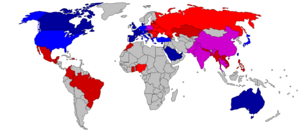Human trafficking
Human trafficking (or Trafficking in human beings) is a way to exploit people. People are sold, bought, traded much like slaves , and are even sold to couples who don't have children. It is estimated to be a $5 to $9 billion-a-year industry.[1] Trafficking victims typically are recruited by using force or because they are deceived, or fraud is used, power is abused, or they are simply abducted. Threats, violence, and economic problems can often make a victim consent to exploitation.
Human trafficking should not be confused with human smuggling.[2][3][4]
General
Exploitation includes forced labour or services, slavery or practices similar to slavery, servitude or the removal of organs. For children exploitation may also include illegal international adoption, trafficking for early marriage, or recruitment as child soldiers, beggars, for sports (such as child camel jockeys or football players), or for religious cults.[5]
The norms based on international human rights law, such as Vienna Declaration[6] and the Yogyakarta Principles[7] prohibit human trafficking and Council of Europe and Charter of Fundamental Rights of European Union also prohibit them and do effort to save the victims.
Child trafficking
Child trafficking is defined as the "recruitment, transportation, transfer, harboring, and/or receipt" of a child for the purpose of exploitation.[8] The commercial exploitation of children can take many forms. It can mean practices similar to slavery such as servitude or the removal of organs, illegal adoption, or recruitment as child soldiers.[9]
Related pages
References
- ↑ "Economic Roots of Trafficking in the UNECE Region".
- ↑ https://www.dailyworld.com/story/opinion/columnists/2017/09/06/difference-between-human-trafficking-and-smuggling/621095001/
- ↑ https://nationalpost.com/news/canada/a-walk-in-the-park-alleged-human-smuggling-operation-may-have-brought-hundreds-of-chinese-migrants-across-b-c-border
- ↑ https://www.international.gc.ca/crime/human-traf-personne.aspx?lang=eng
- ↑ "Agents in the UEFA spotlight".
- ↑ Vienna Declaration, Part I para 18
- ↑ Yogyakarta Principles, Article 11
- ↑ United Nations (2000). "U.N. Protocol to Prevent, Suppress and Punish Trafficking in Persons, especially Women and Children" (PDF). Retrieved February 9, 2012.
{{cite journal}}: Cite journal requires|journal=(help) - ↑ Agents in the UEFA spotlight at the Internet Archive, UEFA, 29 September 2006. (archived from the original on 2009-04-30)
